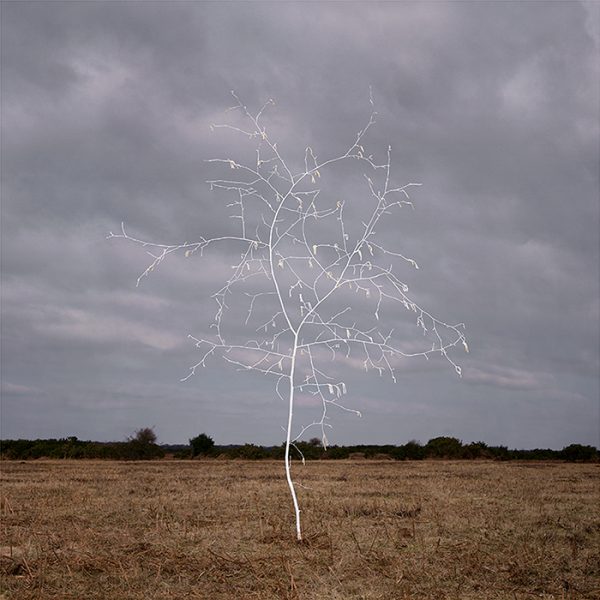Thurstan Crockett, Head of Sustainability & Environmental Policy at Brighton & Hove City Council attended our first tree planting event on Saturday 21 June 2014, and has written a personal reflection of our current show 100: A Making of Trees.
Follow the progress of the 100 Project in a series of posts here on our blog over the coming weeks.
The ONCA gallery’s new exhibition 100: A Making of Trees in Brighton is something special. The exhibition consists of 100 small artworks by artists and young people, on sale for £100 each, to support the planting of 100 new trees nearby, in London Road. It had me reflecting on the importance of trees to my own life, to human culture and creativity, as well as on their central role in our ecosystems.
All this was prompted by a call to help: could I step in for Caroline Lucas MP to do the official slot at a short tree-planting ceremony opposite the gallery? As a big fan of ONCA from the outset – it’s one of my very favourite organisations in Brighton – I was only too pleased to help out.
It was a loose and lovely little ceremony: great music from folk-y Brighton-based Boondock with a random guest, tea-chest/string/broom bassist.
We heard a magical short story on the power of trees from storyteller Abbie Palache, featuring wistful wind-accompaniment from Andreas Kornevall, whose earth restoration service are partnering with ONCA for community plantings of 100 trees. And best of all, a big lime tree festooned with yellow ribbons – which looked great, even though their symbolism baffles me.
The lime tree was selected to continue a line of limes along that stretch of Valley Gardens which the city council is working to improve, with major proposals up before councillors next week that include 285 more trees.
I love lime trees – fantastic bark for stripping and great wood for working – the old word “linden” developed as an adjective “made from lime”.
They have brilliant seed dispersal with nature’s own helicopters; their sticky sap, “honeydew”, deters people from parking underneath them; and I love the way that the aphids attracted to this sap make weird and wonderful spikes in lime leaves.
There’s no connection with the lime fruit tree, of course – though Laura Coleman and her great ONCA Team ensured we had chilled lime tea on a very hot morning.
Why a hundred trees? Well Laura told me it was a good, round number, a challenge to get that many paid for and planted, but achievable. A hundred to me, from my time in Lincolnshire, represents the division of an English county – the area that supported a hundred homesteads. Built, of course, with, and around, their local trees. In Sussex, perhaps because of denser living, we even had “half-hundreds”.
One piece in the gallery to me sums up this connection: Rima Staines’ beautiful piece “To the Great Tree-Loving Fraternity We Belong”.
I spoke about the newly awarded World Biosphere Site status, just granted to the Brighton & Lewes Downs Biosphere Partnership by UNESCO. This aims to serve as a world-class demonstration area of how we might live better in the future, in greater harmony with our local environment, by bringing people and nature closer together. That’s what this project – and ONCA – are all about.
In connection with this, I talked about my choice to bring the freedom and timelessness of nature into my home, my life and my work. And how I got my inspiration for this from a man who planted trees: the late Hugh Kemp, who epitomised sustainable development in his remarkable life of achievement, with trees at its centre, until his untimely death two years ago. With him I planted hundreds: especially oaks, mountain ash, and larch – his favourite.
After the lime ceremony, it was time to see the gallery’s 100 artworks, including some great ones from my son’s school, nearby Carlton Hill Primary. My favourite is “They said a king once ruled the forest” by Lizzie Thomas: it’s witty, brilliantly made, connected so well with Abbie’s story featuring a fickle king, and looks fantastic. You must see this show, but quickly – the 100 theme means it’s only open for a hundred hours – ending on July 6 at 6pm.
Had I entered an artwork for 100 Trees, it would have been a wood-cut, illustrated poem about the hornbeam. About the one I like to think I saved in nearby Richmond Parade when the old church was being redeveloped: I stuck in a plea to the planners after hearing a jay rasping away in it; and the hornbeam staff the fantastic Rob Fallon of Wild Nature handed me for my 50th birthday, on a bushcraft day in the woods with my boy Tom, other dads and their kids.
I feel I now need to make it anyway. Hugh would have approved, and of ONCA: I felt his art was as important to him as his trees, and he created the perfect retreat to paint prolifically in a clearing amongst trees he’d planted 20 years earlier. Making those connections between nature and our own creativity seems to me to be at the very core of human experience.


